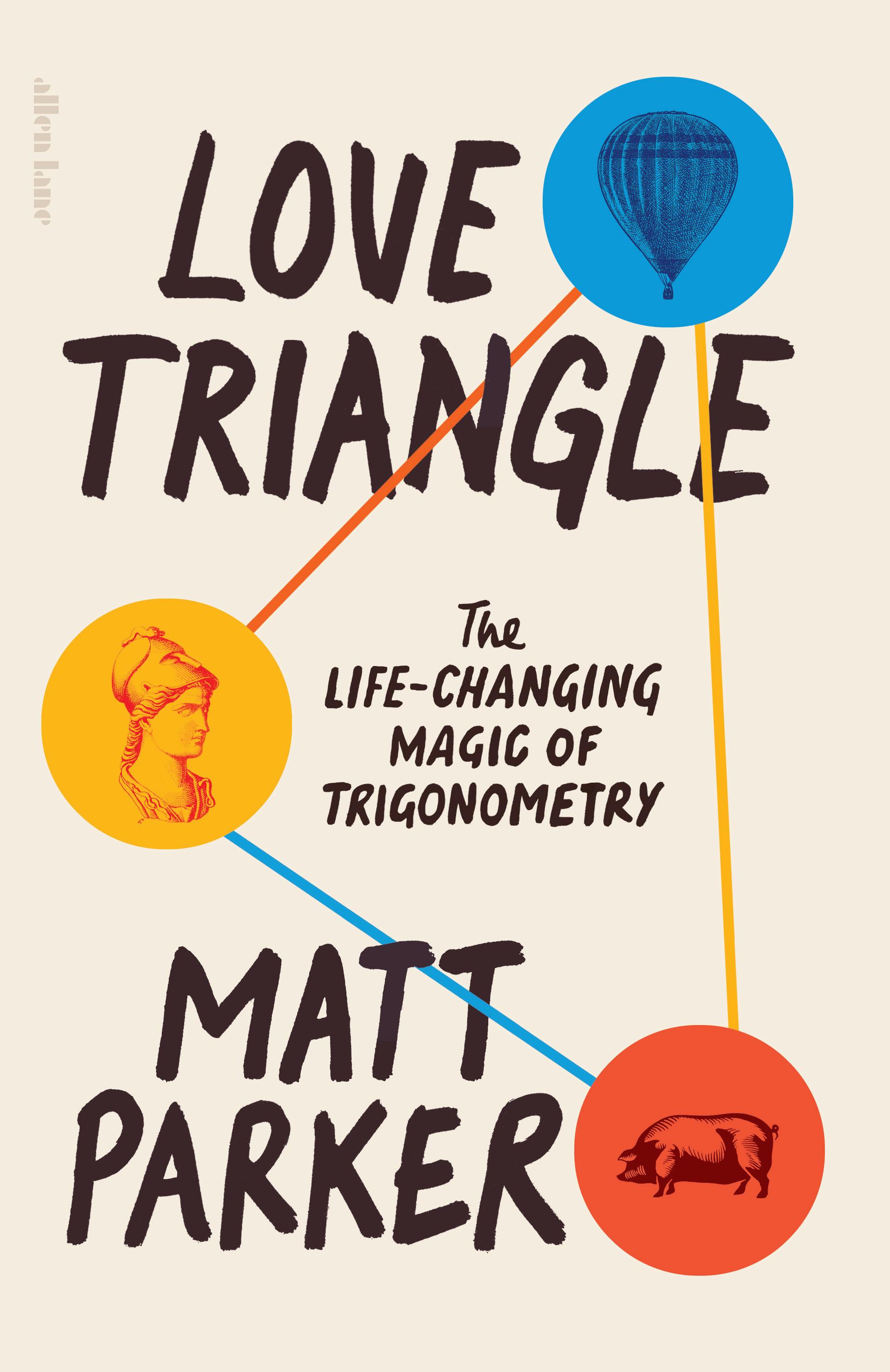

Love Triangle
Love Triangle
The Life-changing Magic of Trigonometry
of
Matt Parker
ALLEN LANE an imprint
ALLEN LANE
UK | USA | Canada | Ireland | Australia India | New Zealand | South Africa
Allen Lane is part of the Penguin Random House group of companies whose addresses can be found at global.penguinrandomhouse.com.
First published by Allen Lane 2024 001
Copyright © Matt Parker, 2024
The moral right of the author has been asserted Set in 13.5/16 pt by Garamond MT Std Typeset by Jouve (UK), Milton Keynes Printed and bound in Great Britain by Clays Ltd, Elcograf S.p.A.
The authorized representative in the EEA is Penguin Random House Ireland, Morrison Chambers, 32 Nassau Street, Dublin d 02 yh 68
A CIP catalogue record for this book is available from the British Library isbn : 978–0–241–50569–4
www.greenpenguin.co.uk
Penguin Random Hous e is committed to a sustainable future for our business , our readers and our planet. is book is made from Forest Stewardship Council® certified paper
Dedicated to my parents, Brad and Judy Parker, who taught me to love triangles
6 Where Do Shapes Come From? 0.438371
Zero INTRODUCTION
In February 2021 a driver stood before the Supreme Court of South Australia, trying to argue their way out of a speeding ticket. Back in March 2019 they had been caught driving their Mitsubishi Magna at 68km/hour in a 60km/ hour zone. They had contested the speeding charge in a lower court, where they lost their case, but had since appealed that decision all the way to the state supreme court. Their argument? That they had put bigger rims on their car, increasing the diameter of the wheel and rendering their speedometer inaccurate. Amazing.
‘I said, Pythagoras and physics, a small circle spins faster than a big circle, what evidence do I need, it’s mathematics,’ they explained to the court. When asked why they did not have any calculations from an expert witness, they declared, ‘I’m not going to pay eight grand for an expert to come.’ Which makes me feel like I’m undercharging for my opinions as a maths expert (I tend to give them away for free, unsolicited).
And in my opinion their defence did have potential. In one sense, yes, ‘a small circle spins faster than a big circle’ when it comes to rolling. The distance around a small wheel is, well, smaller, so it needs to rotate more times to roll the
same distance as a bigger wheel. If the Mitsubishi Magna’s speedometer uses the rotation of the axle to deduce the car’s current speed, it would give the wrong speeds if calibrated for a different size of wheel. All of which would require calculations to back it up.
Calculations the defendant did not have. It does not sound like they argued their case very well at all. The defendant was also a serial speeder, having contested twelve speeding penalties for various reasons over the previous five years. They lost the case.
What I find most interesting, though, is the use of the word ‘Pythagoras’ in the defendant’s argument. The situation, in fact, had nothing to do with Pythagoras. Pythagoras was an ancient Greek philosopher and mathematician who was famously all about triangles, not circles. It seems this chancer wanted to sound more mathsy while trying to fasttalk their way out of a speeding fine, evoking the mysterious ‘Pythagoras’ as a catch-all mathematical deity.
My theory is that Pythagoras’s Theorem is the most advanced mathematics which almost everyone is forced to learn at school. As a result Pythagoras has become a kind of mascot for complicated but kind-of-pointless maths. You know something is burnt into the popular psyche when it is referenced in episodes of both Inspector Morse and Family Guy.
I think it’s a shame that being bored by Pythagoras is most people’s lasting impression of triangles. I love triangles! We all rely on triangles to keep our modern world ticking along. I would argue (and have done, hence the book you’re holding) that triangles unlock some of the most important bits of knowledge ever discovered by humans. Triangles are the gateway to the worlds of geometry and trigonometry. Triangles help us out in our day-to-day lives and enable the civilization around us. Also, I just think they’re neat.
0.017452
Many people leave triangles behind once they’ve finished the compulsory lessons on Pythagoras, geometry and trigonometry only to be abruptly reacquainted once they start their careers. Obviously some life choices will keep you in close contact with triangles. My own experience of being a maths teacher and maths author is one example. Others are far less obvious. Whenever some kind of ‘isn’t maths silly’ thread pops up on social media, there will be a chorus of people contradicting the narrative with stories of their own necessary maths. My favourites include an oilfield driller declaring, ‘Geometry began and ended my day.’ And a machinist chipping in with, ‘I use trigonometry literally every day.’
The oilfield worker even spelled out how unexpectedly vital mathematical knowledge was to their career. ‘One of the things I quickly learned was that your math skills, or aptitude rather, determines how far you can progress in this industry.’ It was through learning geometry that they were able to be promoted from derrickhand (the person who loads the next section of drill pipe) to being the driller in charge of the operation.
Humans have also been using triangles to build the world around us for a very long time. I live just outside London, which was once the ancient Roman city of Londinium. Sometime in the first century bce , the Romans decided to build a road joining Londinium to a town near the south coast of England called Noviomagus, known today as Chichester. Romans famously built straight roads, requiring a solid knowledge of surveying and geometry, but in this case that would not be possible.
Between London and Chichester are the Surrey Hills, featuring one impressive stretch called the North Downs which is as close as England gets to an imposing mountain range.
0.034899
It’s also where I live, which makes walking and cycling scenic but exhausting. While the Romans did not know it would be the future home of me, they did know that the North Downs, and subsequent South Downs, would be too hilly to easily build roads. Even if they did get a straight road through the hills, it would be too steep for any traffic to actually use. So they decided against the straight path between London and Chichester, instead turning their engineering and trigonometric ability to a roundabout route of multiple straight sections which became known as Stane Street.
To see where the straight-line road would have gone, I used Google Maps to draw a direct line between modern London Bridge (site of the first permanent bridge over the River Thames, built by the Romans) and where the east gate of Noviomagus would have been in Chichester. The map told me it was a distance of 88.6 kilometres (55 miles) and, as my gaze drifted down the line, I noticed it came into perfect alignment with a section of the modern A3 road. The A3 turned off into south London, but then my virtual line seemed to be directly on top of a straight section of the A24. Right through the map of modern London, major roads aligned with the straight line between London Bridge and Chichester.
It is not uncommon for current roads and highways in England to follow the path of ancient streets, and suspiciously straight roads are a sure sign the route is Roman. The fingerprint of Roman engineering lives on in the modern road system. These fragments of the A3 and A24 are fossilized remnants of where the Romans put Stane Street. They started building the road directly towards Chichester for the first 20 kilometres before deviating to the east to avoid the North Downs. What startled me, though, is that the road never picks up that line again. The straight sections go around
0.052336
and through what is now Dorking before arriving at the east side of Chichester, but the road never again aligns with the straight-line path.
I couldn’t believe it. The Romans had completed the geometry required to make sure a road goes directly towards its 88-kilometre-away destination, but only for the first 20 kilometres. This would require surveying the entire straightline distance (over two hill ranges) just to make sure the first quarter of the road matched. It would have been a shorter, more direct road if they had aimed straight for the pass through the North Downs, but no, they aimed for Chichester first, spending untold human time, effort and calculations, measuring triangles across difficult terrain, just to show off. Or, as I choose to believe, to celebrate the wonder of using triangles to survey and measure distances and angles.
If you know where to look, you can see signs of the triangles – and geometry in general – which make our lives possible just about everywhere. Mostly they work invisibly behind the scenes thanks to a host of skilled, maths-savvy experts, but every now and then we mortals can see evidence of the secret world of triangles. Sometimes that’s because, like the Romans, someone was showing off.
I believe it is time that more people knew of the wonders of triangles, complete with the geometry and trigonometry triangles make possible. This blasé attitude of not caring about shapes cannot go on! Look at this packet of biscuits. An obviously eight-sided biscuit is labelled as ‘hexagonal’. An eight-sided shape is an octagon! Can you imagine the manufacturers of this packaging allowing a similarly egregious mistake to slip in, like a spelling error or a mislabelled ingredient?
How about a company called Octagon Timber Flooring whose logo is not an octagon but a 3D shape, the icosahedron.
0.069756

That is a bit hard to stomach.

Would you trust these people to measure a room for flooring?
I’m a big fan of an icosahedron – it’s made from twenty triangles after all – but it’s not an octagon. All we need now is a third product or company which is called Icosahedron but is actually a hexagon and we’ll close this cycle of chaos. These other shapes matter just as much as triangles. As I will argue, all shapes boil down to a collection of triangles
0.087156
but, more than that, these situations reveal how surprisingly relaxed we are as a society when it comes to geometric precision. I think it’s a symptom of people viewing geometry as one of the inconsequential things they had to learn at school, the details of which they are now free to forget. With this book, those days will hopefully soon be over.
We already have plenty of people on board, both triangle enjoyers and those who use triangles professionally. Some people who love triangles really love triangles. I know of at least two of my friends who have a tattoo of a triangle. As well as the practical we are surrounded by fun triangles: the omnipresent ‘play button’ symbol is a triangle, the best instrument in an orchestra is the triangle, the ultimate shape to cut a sandwich into is the triangle. Triangles are great!
As I was writing this book under the working title Love Triangle, the fantastic stand-up comedian James Acaster released his Netflix special Repertoire: Recognise containing the joke ‘every triangle is a love triangle when you love triangles’. I couldn’t agree more. I want everyone to love triangles. And to which mathematician did Acaster attribute this fictitious maths catchphrase? Pythagoras, of course.
So let’s plot a path through the world of geometry and trigonometry to celebrate all things triangle. Not a straightline path, but one that picks out a more convenient route through North Down passes and places full of dorks. Wherever you may be on the glad-to-never-do-geometry-again to love-triangle spectrum, I hope I can show you the useful, the vital and the pointless aspects of triangles. Triangles are everything and everything is triangles.
One GOING THE DISTANCE
It’s the first time in twenty-odd years of practice that I’ve had to use a maths expert and it might not be the last.
– Lawyer for the pigs
From a distance, hot-air balloons are a serene form of air transport. Slowly and silently drifting through the sky and looking colourful while they’re at it. Up close, though, they are angry, out-of-control gas barbeques attached to thousands of square metres of fabric and a lifecritical picnic basket. The safest way to enjoy a hot-air balloon ride is from the ground, a fair distance away from it. Specifically, half a kilometre away.
Because the sound of the burners being ignited in a hotair balloon is so loud and terrifying, the UK Civil Aviation Authority has restrictions on where a balloon can fly, so as to avoid farms where the animals could be spooked by a screaming sky orb. In defiance of these no-float zones, in April 2012 a balloon from Go Ballooning flew over Low Moor Farm in North Yorkshire, ignited its burners and caused a pig stampede.
I’ll save you the gristly details but suffice to say the farm
0.139173
lost a lot of pigs that day, including pregnant sows. Because they would now have 800 fewer piglets that season, the farmers decided to sue the balloonists for damages. Go Ballooning insisted their GPS data shows the balloon never dipped below an altitude of 750 metres. The pile of dead pigs suggested it came much closer. And, while the farmers had no proof, they did have a prof.
The best non-pig evidence the farmers could offer was a photo taken by one of their neighbours, who was far enough away for the hot-air balloon to be back in the ‘serene’ category. From their vantage point the balloon looked quite pleasant (the pig carnage was hidden behind some trees), which is why they took a quick snap. Along with that photo, the farmers had the power of maths. And not just any maths: triangles.
The farmers’ lawyer reached out to the mathematics department at the University of York and Professor Chris Fewster took the case. Fewster’s actual area of research is not calculating balloon altitudes but rather quantum field theory and the curvature of spacetime. Which, it could be argued, qualifies him to measure balloons up to several light-years in size. At a minimum, he was capable of wielding some triangles. When I asked Chris about it, he said calculating the altitude of the balloon involved ‘little more than trigonometry and some understanding of how a camera works’.
Fewster could work out how high the balloon was from a single photo because triangles are ‘nature’s sudokus’, just waiting to be solved. In fact, they are more like a series of interlinked sudokus where each one provides some clues for the next. All Fewster had to do was find a series of triangles in the photo and get solving. Sometimes the only difference between doing geometry for a practical purpose and doing it for fun is the context of the triangles.
0.156434
Pigonometry
Fewster had some information about the photo: he knew where it had been taken and how big the balloon was. There were also some trees visible in the photo, which he knew the location of and, after returning to the scene of the flying, had measured with a golf laser range-finder (it appears golf has become more high-tech than I appreciated) so he also knew how tall they were. These measurements were like the clues already in the sudoku, and thanks to triangles he could now fill in all of the missing numbers.
The superpower of triangles – what makes them useful here and in so many other practical applications – is that they are easy to decode. Every triangle is made of three sides and three angles. And if you know as few as half of those measurements, you can swiftly calculate the rest. Know only the lengths of all three sides of a triangle? No problem: you can quickly use trigonometry to find the exact size of all three angles. You can only measure one side and two angles? Boom. You’ve got all other side-lengths and angle sizes without lifting a finger (except to use a calculator). Actually, I’d like to update my analogy. Triangles are like a super-easy crossword where you get half the letters and the answer is always ‘triangle’.
I used exactly the same type of triangle trickery when NASA released this photo of the Moon in front of the Earth in 2015. It was taken by the Deep Space Climate Observatory satellite which had the Sun behind it and was looking directly at the Moon in front of the Earth. It’s a fascinating photo, showing the alien ‘dark side of the Moon’ completely lit by the Sun with our familiar Earth in the background. I think it made most people reflect on how the far side of the Moon is called ‘dark’ because we can never see it
0.173648
from our point of view on Earth, not because the Sun never illuminates it. My first thought, purely because I wanted a reason to try and work it out, was ‘I wonder how far away that spacecraft is from Earth?’
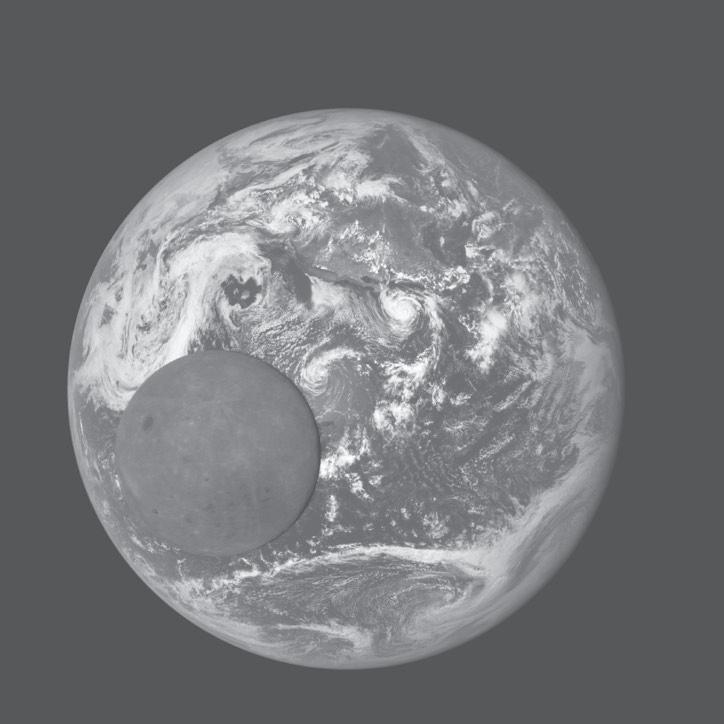
If you measure the relative sizes of the Earth and Moon in this photo, the Moon comes out to be 36.6 per cent of the width of the Earth. Which is too big! In reality, the Moon is only 27.2 per cent as wide as the Earth. The photo makes the Moon look bigger than it is because the Moon is closer to the camera than the Earth. Which makes sense; on average the Moon keeps a healthy 384,400-kilometre distance away from the Earth.
I calculated that for the Moon to look that specific amount bigger, it would have to be 74.3 per cent of the way from the spacecraft to the Earth. I knew the rest of the distance from the Moon to the Earth was 384,400 kilometres, and so it took a mild bit of algebra to calculate the total spacecraft– Earth distance. Which I think we all know I did. Details below if you want to double- check my working out.
0.190809
My crude calculations gave me a distance of roughly 1.5 million kilometres, which is around 930,000 miles. The NASA press release provided with the image said the spacecraft had taken the photo ‘from a million miles away’. It seems both NASA and I are giving approximate answers. And even though my calculation has ignored all details of the space camera’s actual optics in favour of some quickly sketched triangles, I dare say I’m closer to the true answer.
Chris Fewster did not have the luxury of ignoring the optics of the camera which took the hot-air balloon photo. He even factored in the angle the camera would have been pointing when taking the photo. Fewster was able to solve all of the triangles and calculated that the hot-air balloon was between 750 and 760 metres from the camera, which put it around 300 metres from the pigs. Much closer than the balloon operators had argued it was. They were, in the English vernacular, ‘telling porkies’. Thanks to Fewster’s mathematical expertise, the farmers won a decent settlement. When
I asked him about the whole incident, Fewster said he was pleased to have given ‘a good example of how even basic maths can make a difference’.
The One Annoying Step
The only hitch with solving triangles is that you need to know at least one side-length. Earlier, when I said you could solve all the values of a triangle (all three sides and all three angles) with ‘as few’ as half of the measurements, I was covering myself because at least one of those measurements needs to be a length. This may sound obvious, but if you don’t know how big a triangle is, then it could be any size.
Two triangles can have all of the same angles, yet be vastly different sizes. Imagine watching a triangle coming towards you. Hopefully a friendly one. As you wonder what you did to attract the triangle’s attention, you may also notice that, even though it is looking bigger and bigger, the angles are always the same. It’s like how if you walk away from a clock the hands may look smaller but the time doesn’t change (well, depending on how fast you walk). The point being, if you’re using triangles to calculate a distance, all the angles in the world will not help you unless you also measure at least one side of at least one triangle.
When my friend Hannah Fry and I needed to know how tall the Shard is (the tallest building in London, right by London Bridge), we did it with triangles. Yes, we could have just looked it up, but that would defeat the purpose. We wanted to recreate one of the earliest ways of measuring the size of the Earth, which used a mountain. London is sadly bereft of mountains so we swapped in a skyscraper and, true to the exercise, we calculated its height ourselves. Mathematics can 0.224951
so easily become clinical calculations on a page but we wanted the experience of doing the literal legwork.
I had hand-crafted my own giant protractor, which we used to measure the angle from the ground to the top of the building from two different locations. Which would all be for nothing if we didn’t also know a distance. Luckily, I’d also made attachments for my shoes which were exactly 50 centimetres and stepped out 100 metres between our two angle measurements of 22.9° and 20°. Some quick number crunching later and we had a height of 263 metres, which is reasonably close to the official viewing-deck height of 244 metres. Not bad for a home-made protractor and carefully calibrated clown shoes.
e Shard
100 m = 200 clown-shoe steps.
But awkwardly taking exactly-50-centimetre steps while a friend pretends they don’t know you is not the only option. On a visit to Japan, I learned that Tokyo had the tallest tower in the world: the Tokyo Skytree. Tokyo is very keen to specify ‘tower’ because there are two buildings taller than it: the Burj Khalifa in the UAE and the Merdeka 118 in Malaysia. Apparently, buildings can be used for residential or commercial purposes whereas a tower is as useless as it is skinny.
The Tokyo Skytree is the tallest pure tower. But, you’re wondering, how tall is it? I was too. So I measured it with a ruler. If two triangles have identical angles, we say they are ‘similar’. This just means they are the same triangle but scaled up or down. Hence if you know the length of any side in any one of them, and the scale between them, you can solve for all lengths. So I picked up a map of Tokyo. What is a map, if not a scale model of the city it represents? The best physical map I could find had a scale of 1 to 20,000. Which means that if I could find a pair of similar triangles – one on the map and one in real life – I could measure the map one with a ruler and know that every 1 map millimetre would represent 20 real-world metres.
I set off across the streets of Tokyo, dodging through crowds and wandering down backstreets, trying to find the end of the shadow cast by the SkyTree. Eventually the top of the shadow passed over what seemed to be a viewing-deck area next to a train line, and I was able to set my map down at its exact terminal point. I took out my ruler and stood it up on the map at the exact point where the real-world tower stood. To be fair, I’ve just used the word ‘exact’ twice, which I fear may be over-selling my accuracy. It was a partly cloudy day in a very built-up city but I was doing the best I could.
I was now looking at two shadows: one made by the actual tower, cast onto the streets of Tokyo, the other made by a ruler on a scale map of the same city. Importantly, both shadows were being made by the same sun. The Earth’s Sun. And my ruler was at right angles to the ground, just like the tower tends to be at all non-Godzilla points in time. That meant the triangle made by the tower and its shadow was a similar triangle to the one made by my ruler and its shadow, which ended at the same point on the map.
As the ruler was transparent, it was casting a projection of 0.258819
the measurement notches on the map. I had a look to find the one which was right on top of where the actual shadow ended. 28 millimetres. I now knew that if a 28-millimetre-tall mini-tower was placed on my 1-to-20,000 map, it would cast exactly the same shadow on Map Tokyo as the SkyTree did on Real Tokyo. Multiplying 28 millimetres by 20,000 gave a height of 560 metres. Now that is a tall tower! Over half a kilometre high! Sure, the tower is actually 634 metres high and I was off by 74 metres, but for eyeballing a low-detail tourist map on uneven ground I’m very happy being within 12 per cent of the true height. If I’d just decided the ruler shadow was an extra 3.7 millimetres I would have been spot on!
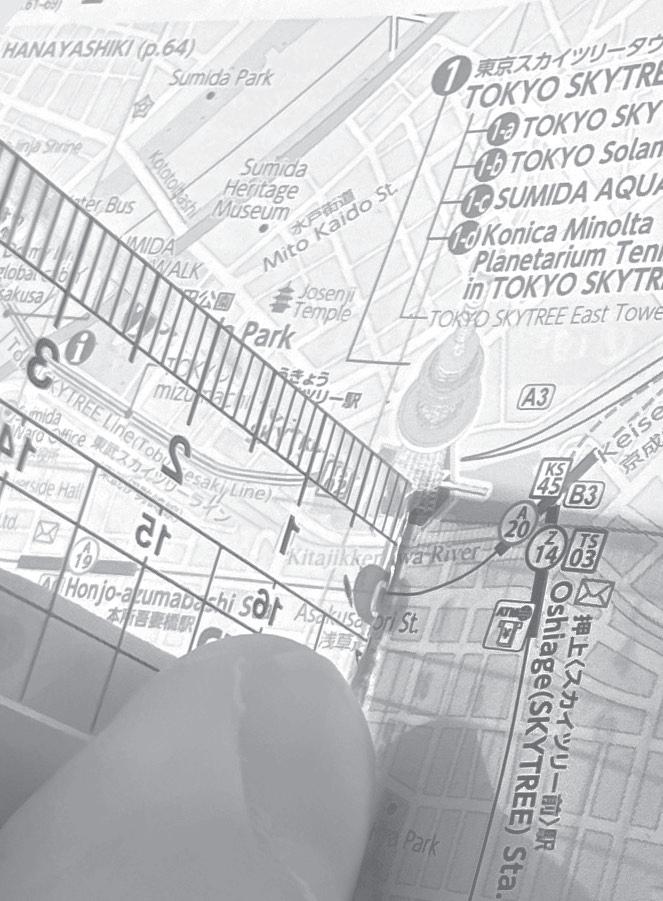
I was standing roughly here
Even on holidays I try to stay very measured.
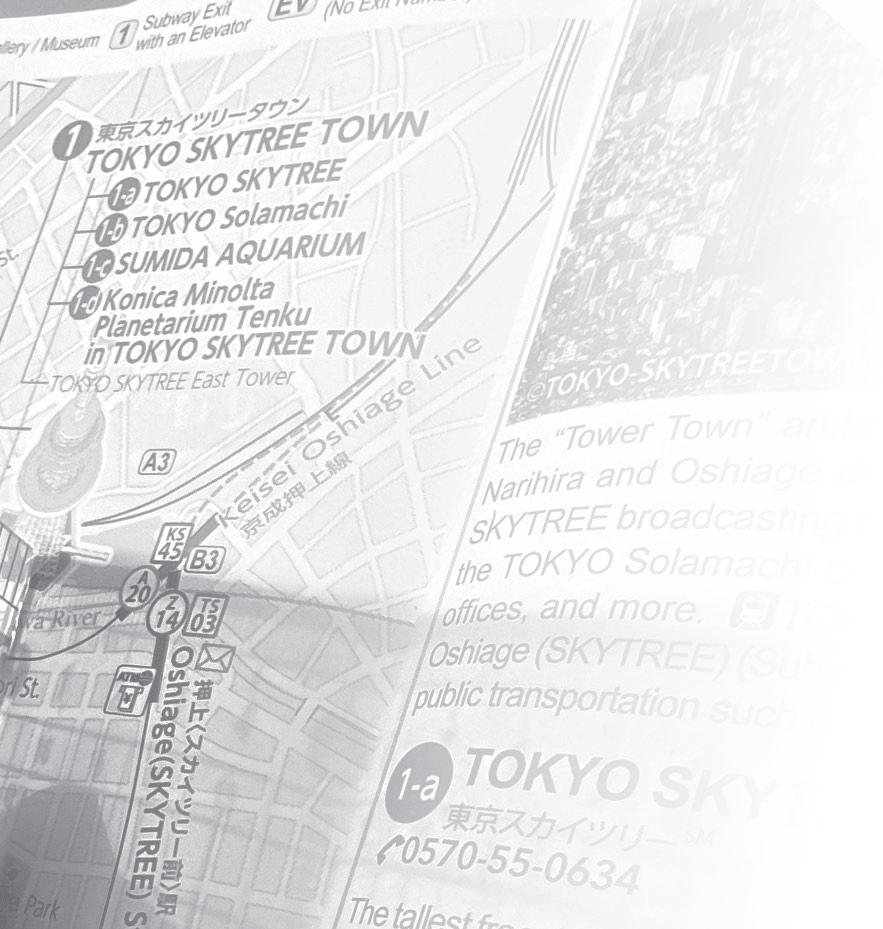
I’m far from the first person to use a shadow to measure the height of something. I’m not even the first person to use a shadow to measure the height of the world’s tallest tower. In the 500s bce there was a Greek individual named Thales of Miletus who apparently used shadows to measure the height of the world’s tallest tower (while on vacation,
0.275637
I assume). In Thales’s case he was in Egypt visiting the Great Pyramid of Giza.
There are conflicting reports of how Thales went about this measurement. Some versions of the story say that he waited until the exact moment in the day when his shadow was equal to his height. This is the moment when the solar shadows hit the ground at exactly 45°, meaning that anything standing straight up would form a right-angle isosceles triangle, where the length of the shadow is exactly equal to the height of the object. At that magical time of day you can measure the shadow of anything and it will give you the height of the object.
The difficulty is that you need to be there at just the right time for it to work. Other writers describe Thales doing exactly what I did: measuring the shadow of a stick standing at the tip of the pyramid’s shadow. But Thales could not just walk into the nearest tourist centre and ask for a free map like I did. He had to also measure the length of the pyramid’s shadow to get the scale factor. But once he’d done that extra step his calculation would have been identical to mine.
The important point is, when I spend time running around cities with a ruler and a map I’m continuing an ancient tradition of mathematicians on holiday, and not, as my friends and family claim, ‘wasting my vacation time’ or ‘confusing the locals’.
Triangles of the Ancients
The pyramids are old. As those stones were being dragged into place, woolly mammoths were still roaming around hoping these new pesky humans were not going to be a problem. When Thales of Miletus decided to try measuring their height, they were already over 2,000 years old. And it would have taken some serious maths to build them; humans have been using geometry for a very long time.
0.292372
One of the earliest mathematical texts is a papyrus from Egypt, and sure enough it has a bunch of triangles slap bang in the middle. Sometime around 1550 bce a scribe named Ahmes made a copy of an even older document from a few centuries earlier. That original document is long lost. And the handful of other, older maths documents we do still have are largely anonymous, making Ahmes arguably the earliest ever named maths author. Which I feel a profound connection with because every few years, for a tiny window of time after I publish a book, I once again become the latest ever named maths author.
The Ahmes Papyrus is now kept in the British Museum. It’s believed it was originally nicked from a ruined building near the Ramesseum (temple of Ramesses II, much like I call my house the Mattesseum), but that is impossible to confirm. At some point the papyrus pinchers cut it into two pieces of 3 metres and 2 metres long, potentially to increase the resale value of now-multiple papyri. It was sold in 1858* and eventually donated to the British Museum.
Because the publication of this book would mean that Ahmes and I would once again bookend all of human known-authorship mathematical literature, I asked the British Museum if I could visit the papyrus. Due to the detrimental effects of light on papyri it is rarely put on public display, but they very kindly brought it out of its darkened storage room so I could take a gander. The first thing which struck me was that it was clearly a mathematical text. I could see triangles all over it.
* It was bought by Scottish lawyer A. H. Rhind, and so is often called the Rhind Papyrus. An 18- centimetre chunk from the middle was sold separately, some of which turned up in the New York Historical Society’s collection in 1922, but the rest is lost.
0.309017
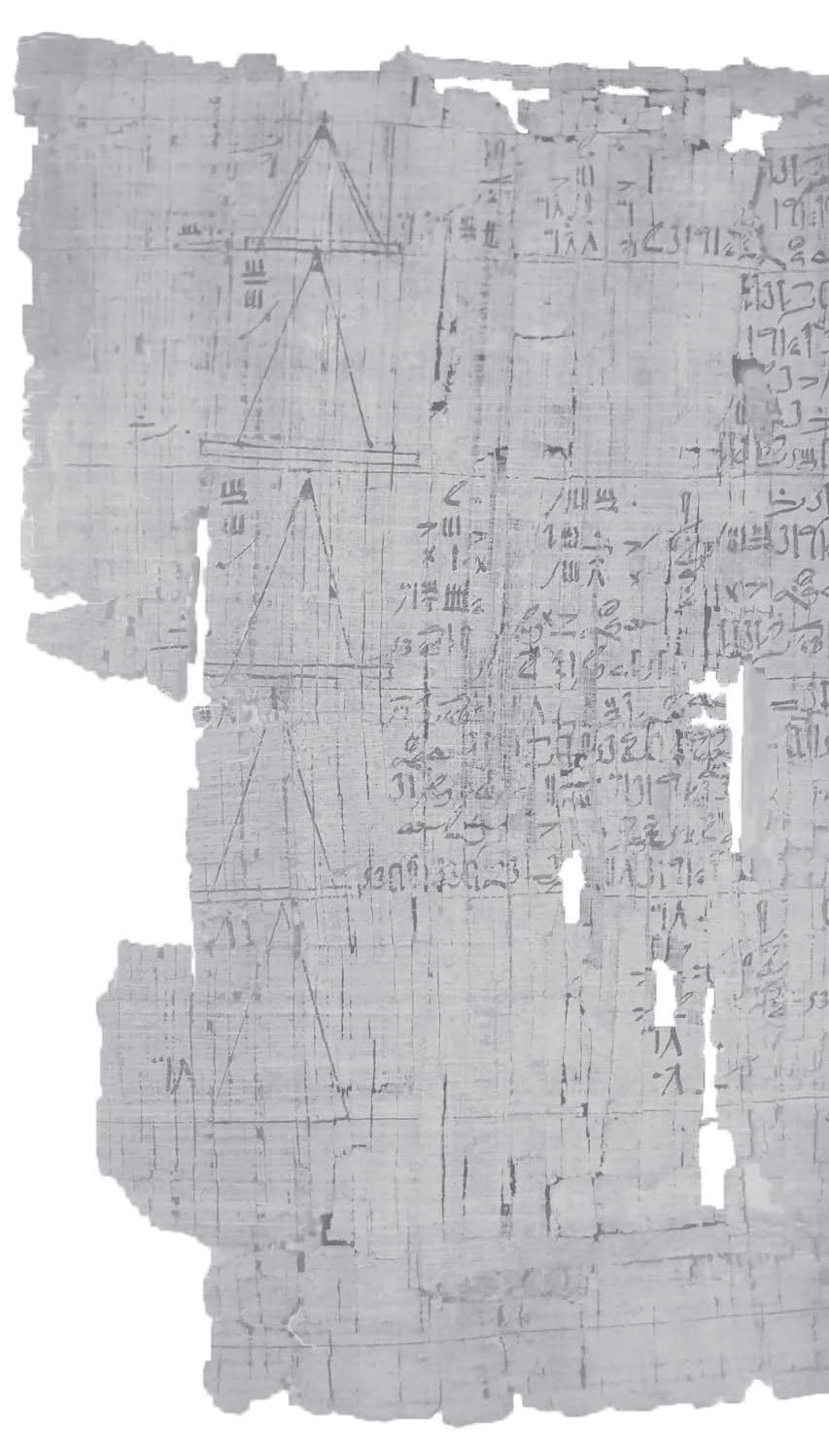
Unmistakably
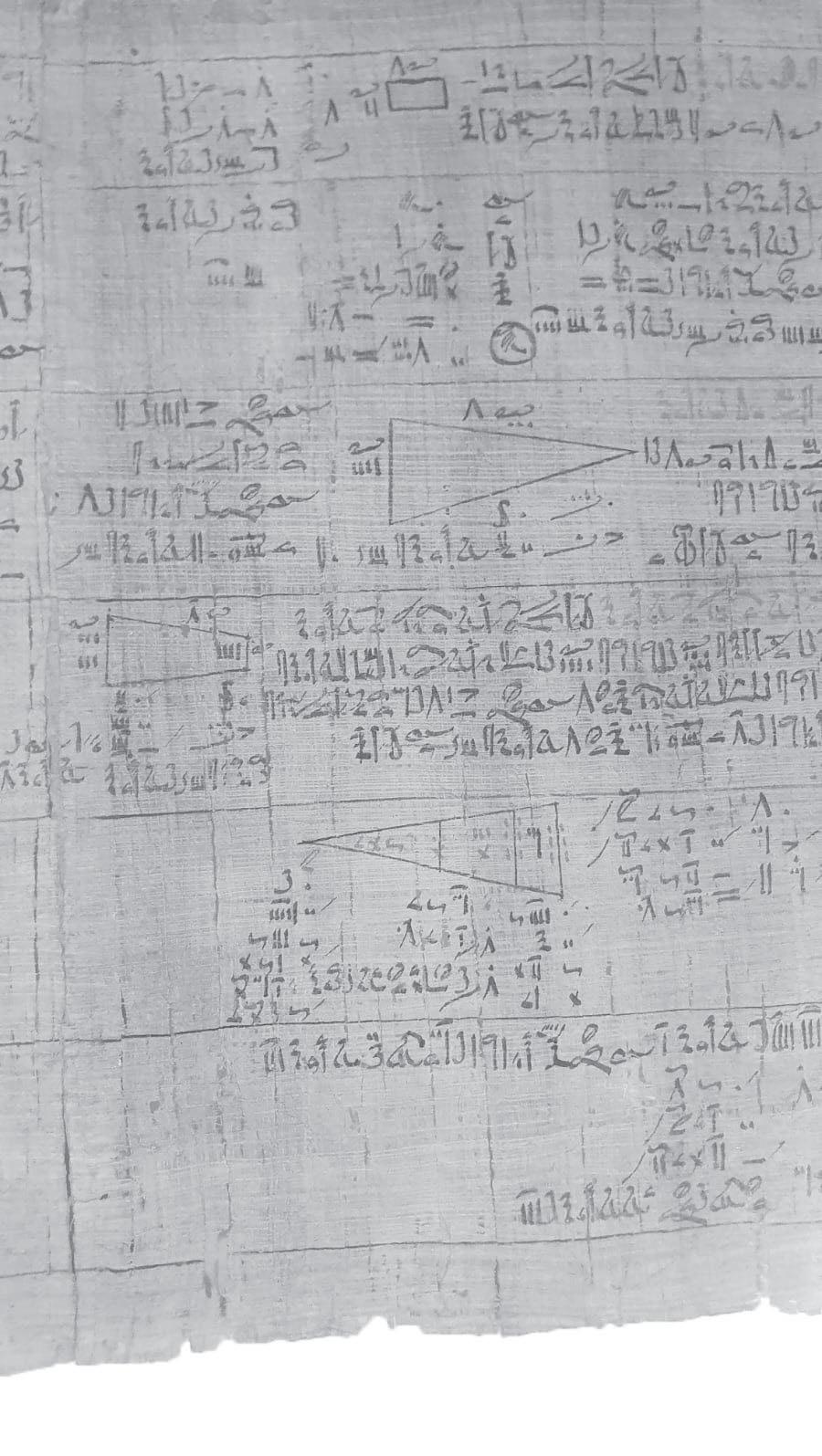
triangley.
The Ahmes Papyrus is basically an ancient textbook that presents a series of maths problems and then shows the calculation tricks required to solve them. The triangles which had first caught my eye are a series of problems about calculating the slopes of various pyramids, which does feel a bit too clichéd to be true. But, in a real sense, looking at the problems which were deemed important enough to go into a textbook gives us an insight into what that society was like. Within limits, of course. Imagine what historians thousands of years from now will make of our modern ‘Mary is buying seventeen watermelons and two hats’- style problems. Twenty- first- century textbooks will give the impression we did a lot of shopping and bought silly things.
0.325568
The Ahmes Papyrus contains around eighty-eight different problems along with guides to solving those problems. As always, the ancient obsession with bread and grain shines through: ten of the problems are about how to divide a number of loaves of bread between a certain number of people. Six examples show how to calculate the volume of grain in variously shaped granaries. But then things take a turn for the much more geometrical. As well as the pyramid calculations, there are six problems that involve calculating the areas of plots of land. Clearly there had been some discussions about how to fairly reallocate land, presumably after the Nile had flooded and removed the previous dividing markers.
Ancient Egyptians thrived because of the fertile foodgrowing soil deposited by the routine flooding of the river Nile. This obviously motivated them to develop some advanced astronomical and calendar maths to predict when this was going to happen each year (leading to the direct ancestors of our modern calendar), but they also needed to know how to re-divide the land after the waters cleared. Here we see the birth of geometry from the need to calculate the exact size of plots of land.
And this is not just my speculation: the ancient Greek historian Herodotus proposed the same idea when writing The Histories in 430 bce . He also added the extra flavour of suggesting that Egypt gave the world geometry because the Nile flooded each year, whereas Babylon (which was a team effort with the earlier Sumerian civilization) produced all the other maths things.
And any man who was robbed by the river of part of his land could come to Sesostris and declare what had happened; then the king would send men to look into it and calculate the part by which the land was diminished, so
0.342020
that thereafter it should pay in proportion to the tax originally imposed. From this, in my opinion, the Greeks learned the art of measuring land. The sunclock and the sundial, and the twelve divisions of the day, came to Hellas from Babylonia and not from Egypt[.]
– Herodotus, The Histories, Book II, paragraph 109
So millennia ago people were already writing about the ancient human use of maths to solve arguments. And to sort out tax problems, it seems. In this situation the farmer wants to pay the minimum amount of tax but the king wants to maximize; hence everyone is motivated to get the maths exactly right.
It was humbling to look at the Ahmes Papyrus and realize it was a remnant from 4,000 years ago, when a need to divide land up fairly led to the birth of geometry as an area of human knowledge. I was particularly amazed to see a problem involving the area of a circular field which required a rudimentary value of pi. I followed the calculation and they were using an effective value of pi approximately equal to 4 × (8/9)2 = 3.16, which is close to the true value. But more importantly these hieroglyphics were the gateway to all the amazing abstract mathematics involving our friend pi that humans would go on to find. I snapped a quick selfie with the maths problem, much to the amusement of the nearby historians.
From France to the Galaxy
Forget large fields and the tallest towers, let’s skip right to the end and find the biggest thing we can possibly measure with triangles. As well as our instinct to look at big things and want to know exactly how big they are, humans love looking up at
0.358368
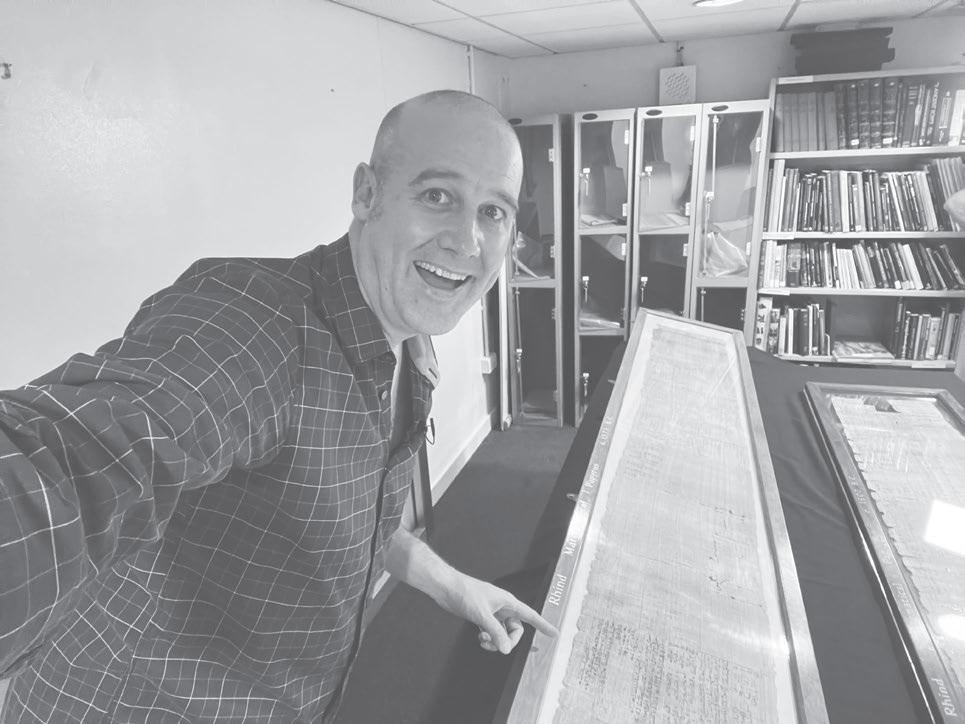
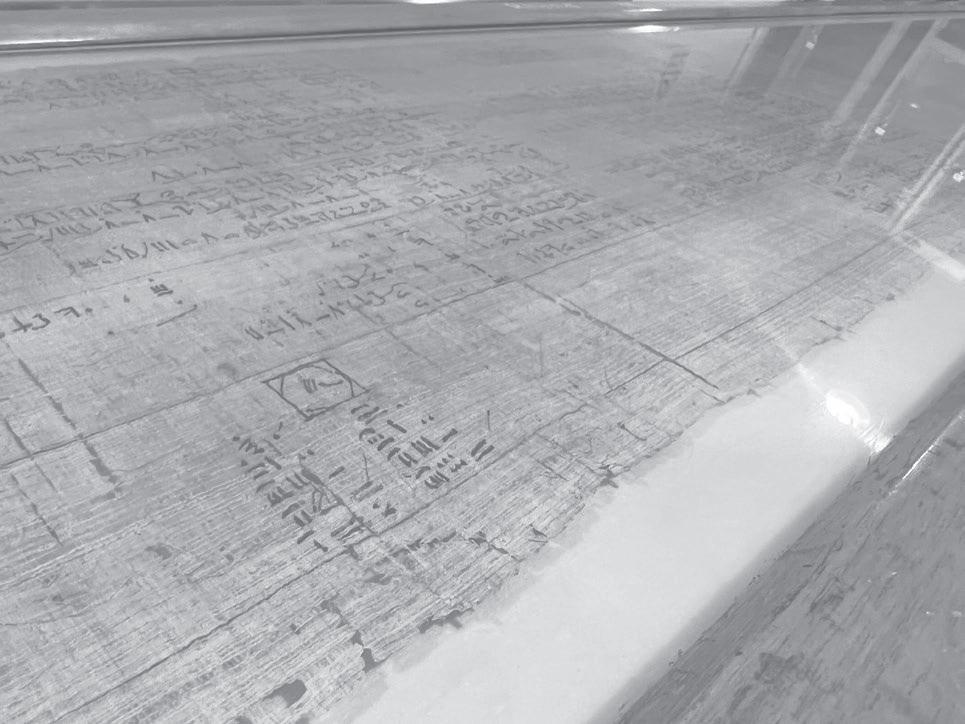
Inside that box is a sketch of the circular field; everything below is numbers.
the night sky. For millennia we must have also been wondering how far away the stars are, with no earthly way to complete that measurement. We’re going to do it. We’re going to use triangles to calculate exactly where we humans sit in the universe. We’re going to measure something astronomically big.
0.374607
An old maths artefact pointing at a papyrus.
Right at the top of the ‘big things in space’ hierarchy, which, as a quick reminder, goes:
– We live in a solar system of one star* and several planets, plus some other rocks and dust.
– A bunch of stars all together form a galaxy.
– A bunch of galaxies makes a cluster.
– Put a group of clusters together and you’ve got a supercluster.
– Those superclusters are then arranged in what is called the Cosmic Web.
If we could identify and name parts of the structure of the Cosmic Web they would be the biggest things our current scientific understanding allows us to measure. You can think of the Cosmic Web as a bit like the terrain of the Earth, with all its ups and downs. Within the chaos of that terrain there are aspects which are clearly all part of the ‘same thing’, and so we give them a name. Like ‘the Grand Canyon’, ‘Mount Everest’ or ‘that hill I regret cycling up’. The Earth’s surface may be continuous, but we understand these sections as cohesive entities we can name and measure.
The Cosmic Web is more complicated than the surface of our planet: it is a 3D foam of galaxy superclusters bigger than we can comprehend. But it’s out there. Or rather, it is all around us. When you look up at the night (or, indeed, day) sky it is right there, expanding out in every direction. Except it’s of a size so far beyond us that there is no immediate local structure to see. You could walk the Nullarbor for a lifetime and never understand the shape of Australia. For that, you need to get a fair distance away and look back.
* By mass our solar system is over 99 per cent the Sun, so in all honesty we’re just a rounding error to our local star.
0.390731
The structures within the Cosmic Web are so big that only sections which are a long way away can fit within the viewing field of our humble human telescopes. And that is a loooo . . . oooong way away (‘long’ with twenty- six o’s). The problem with being that far away is that so little of the light from those superclusters reaches Earth that we cannot detect them. The only thing we can see at such a distance is something called a gamma-ray burst. Second only to the Biggest of Bangs, a gamma-ray burst is the most energetic event in the universe. We’re talking a massive star supernova-ing itself to become a black hole. Or two neutron stars getting to know each other a bit too well. We’re actually not sure: no two gamma-ray bursts appear to be the same. ‘Gamma-ray burst’ is more of a catch-all term for when something of unimaginable energy occurs and a burst of gamma rays (very high-energy photons) blasts across the universe.
Which appears as a tiny blip on our detectors. Often a quick blip: one in three gamma-ray bursts are over in about two seconds. Combined with how hard gamma rays are to ‘focus’, they are very hard to study. They were only discovered in the 1960s, by accident, when countries started investing in nuclear-explosion-detecting technology. Even in a secret nuclear test, the reaction will send gamma rays every which way right across and through the Earth, and so finely calibrated gamma-ray sensors were developed to detect these tests from countries away. But then they spotted faint spots of gamma rays coming from space.
‘Faint’ is relative, of course: they are actually extremely energetic, just a long way away. And they are also quite rare. Turns out it’s a once-per-galaxy, every-couple-hundredthousand-years-or-so situation. Which is good for us: a gamma-ray-burst event anywhere near Earth would be less a tiny space-flash and more an extinction-level disaster. But
0.406737
because there are something like 100 billion galaxies within eyesight of Earth, these events happen fairly often across the universe as a whole.
To actually study these fleeting death-blips, humans needed a way to detect the gamma rays and immediately point a telescope in the source direction to see what offEarth was going on over there. And, believe me, a space scientist has never met a problem they think a spacecraft cannot fix. So in 2004 the Swift Gamma-Ray Burst Explorer was launched, a NASA effort with hardware from around the world. Fun fact: the UK space lab where my wife works built one of the optical detectors.* As soon as a burst was detected, the goal was to have the spacecraft swing around to point in the direction the extreme-energy gamma-ray photons had arrived from. While it couldn’t spin around within the two seconds, it could get there fast enough to spot any lower-energy photon afterglow.
A bunch of interesting science things were obviously discovered blah blah blah. But that is a different story for a different book (one written by my vastly more qualified wife). What we care about is the statistical distribution of those gamma-ray events. And for the most part they were randomly arranged in the sky, basically indicating that whichever way you look, there are a bunch of galaxies over there.
Which is not to say they were completely evenly distributed. Random does not equal even. If you start flipping a coin and it perfectly alternates between heads and tails you wouldn’t see that as random. Quite the opposite. And the gamma-ray
* Which means my research for this section mainly involved opening my study door and yelling my questions into the house. True to her profession, my wife’s most common response was to suggest I launch myself into space.
0.422618
